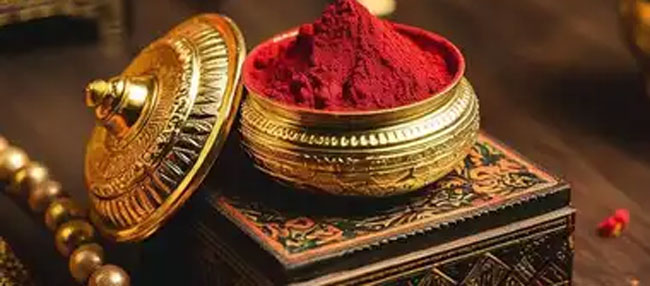In Hindu culture, sindoor (vermilion) is not merely a cosmetic item—it is a sacred symbol of faith, tradition, and  marital commitment. Applied in the parting of a woman’s hair (known as the maang), sindoor signifies that she is married and blesses her with prosperity and her husband’s long life. Deeply rooted in religious beliefs, sindoor also holds psychological and health-related benefits that go beyond its ritualistic use.
marital commitment. Applied in the parting of a woman’s hair (known as the maang), sindoor signifies that she is married and blesses her with prosperity and her husband’s long life. Deeply rooted in religious beliefs, sindoor also holds psychological and health-related benefits that go beyond its ritualistic use.
🌺 Religious Importance of Sindoor
- Symbol of Marital Bliss and Good Fortune:
In Hinduism, sindoor represents the married status (suhag) of a woman. Applying it in the maang is believed to invoke blessings for her husband’s long life and her family’s well-being. It is a visible mark of commitment and fidelity. - Association with Goddess Shakti:
Sindoor is deeply connected with Goddess Parvati, the consort of Lord Shiva. It is believed that after her marriage, Parvati began applying sindoor, and thus married women apply it in reverence to her, seeking her blessings for a happy and long married life. - A Vital Element in Rituals:
Sindoor is used in several religious ceremonies and rituals. In worship, especially of feminine deities, it is offered as a sacred item. Festivals like Karva Chauth, Teej, and Navratri place special emphasis on sindoor, highlighting its cultural importance.
🌿 Scientific and Ayurvedic Benefits of Sindoor
- Stimulates the Agya Chakra (Third Eye):
The spot where sindoor is applied—the center of the forehead—is known as the Agya Chakra or the third eye. According to yogic science, this point governs intuition, focus, and calmness. Applying sindoor can stimulate this area, promoting mental clarity and reducing stress. - Natural Antiseptic and Health Booster:
Traditional sindoor is often made from turmeric, lime, and herbal ingredients, which have antiseptic and healing properties. These ingredients may help protect the scalp and skin from infections. - Improves Blood Circulation:
The pressure applied while applying sindoor can help enhance blood flow in the forehead and scalp area. It may also help relieve headaches and reduce the risk of migraines when used regularly and correctly.
🌸 Sindoor in the Modern Era
In today’s world of rapid modernization and global influences, the use of sindoor has evolved. While many women may not wear it daily, it continues to hold a special place during festivals, rituals, and family functions.
For some, sindoor is a personal choice and a source of pride, reflecting their identity, marital joy, and cultural roots. For others, it’s a spiritual reminder of love, devotion, and blessings. The simple red line of sindoor carries with it centuries of meaning, emotion, and reverence.
🔱 Conclusion
Sindoor is far more than a decorative red powder—it is a sacred emblem of devotion, strength, and womanhood. Whether seen as a religious symbol, a cultural tradition, or a source of spiritual power, its significance in a woman’s life in Hindu society is profound.
🪔 “Sindoor is not just a mark on the forehead—it is a line of tradition that connects a woman’s soul to her family’s fortune and her husband’s longevity.”




